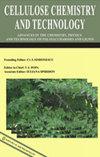γ和电子束辐照甘蔗渣形态结构变化的比较分析
IF 1.1
4区 农林科学
Q2 MATERIALS SCIENCE, PAPER & WOOD
Cellulose Chemistry and Technology
Pub Date : 2023-02-28
DOI:10.35812/cellulosechemtechnol.2023.57.06
引用次数: 0
摘要
甘蔗渣是纤维素和半纤维素的丰富来源,可水解产生可发酵糖,可用于生产生物燃料和其他高价值的生物化学品。要做到这一点,必须使其能够水解化学物质和酶。辐射暴露是最有效和绿色的技术之一处理。本研究研究了γ和电子束辐照对甘蔗渣物理、化学、热学和形态特征的影响。使用Co60以2.5kGy/h的剂量率和2.5kGy/次的剂量率的电子束用伽马辐射照射甘蔗渣。最大剂量变化至1000kGy,并且在500kGy剂量暴露下观察到蔗渣的物理化学特性的变化。蔗渣的物理外观(经过伽马和电子束处理)从米白色变为黄色,而超过500kGy,样品变得蓬松。随着辐射剂量的增加,在Co60γ暴露后,纤维素含量从48%降低到36%,在1000kGy的电子束暴露后降低到16%。发现在1000 kGy的Co60γ暴露后,半纤维素含量从31%降低到16%,但在电子束辐射后,它增加到39%。木质素组分在任何处理后都没有太大变化,在伽马和电子束辐射暴露后,发现其分别在19-20%和17-23%的范围内。在大多数辐照样品中,X射线衍射(XRD)证实,随着高达1000kGy的辐射剂量的增加,结晶度指数显著增加。然而,在电子束照射后,观察到蔗渣的结晶度指数下降。扫描电子显微镜(SEM)分析显示,高能辐射(伽马和电子束)对结构造成了显著破坏。粒度分析表明,随着辐照剂量的增加,颗粒呈碎片状,但在电子束处理的情况下,分布更为突出。在生物质的热研究中,观察到分别受到伽马和电子束辐射的样品的导数热重(DTG)峰从原料蔗渣中的339°C降低到295°C和303°C。研究期间观察到的物理化学变化清楚地表明,木质纤维素生物质的电离辐射暴露导致其基质崩解,这可能使其易于获得水解化学物质或酶。因此,可以得出结论,尽管本文研究的两种电离辐射都可以实现分解生物质结构的目标,但伽马辐射比电子束辐射更有效。“本文章由计算机程序翻译,如有差异,请以英文原文为准。
COMPARATIVE ANALYSIS OF MORPHOLOGICAL AND STRUCTURAL CHANGES IN GAMMA AND ELECTRON BEAM IRRADIATED SUGARCANE BAGASSE
"Sugarcane bagasse is an abundant source of cellulose and hemicelluloses that could be hydrolyzed to yield fermentable sugars, which can be utilized for the production of biofuel and other high-value bio-chemicals. To do so, it has to be made accessible for hydrolyzing chemicals and enzymes, and radiation exposure is one of the most effective and green techniques, among other physico-chemical processes. The present study investigated the effects of gamma and electron beam (e-beam) irradiation on sugarcane bagasse, with respect to changes in its physical, chemical, thermal and morphological characteristics. Sugarcane bagasse was irradiated with gamma radiation, using Co60 at a dose rate of 2.5 kGy/h, and electron beam at a dose rate of 2.5 kGy/pass. The maximum dose was varied up to 1000 kGy and changes in the physico-chemical characteristics of bagasse were observed at 500 kGy dose exposure. The physical appearance of bagasse (after gamma and e-beam treatments) changed from off-white to yellow in colour, while beyond 500 kGy, the samples became fluffy. With an increase in the radiation dose, the cellulose content reduced from 48% to 36%, following Co60 gamma exposure, and to 16% after e-beam exposure at 1000 kGy. The hemicellulose content was found to reduce from 31% to 16% after 1000 kGy of Co60 gamma exposure, but after e-beam radiation, it increased to 39%. The lignin fraction did not change much after any of the treatments, and was found to be in the range of 19-20% and 17-23%, after gamma and e-beam radiation exposure, respectively. In most of the irradiated samples, X-ray diffraction (XRD) confirmed a significant increase in crystallinity index with the increase in the radiation dose up to 1000 kGy. However, a decrease in the crystallinity index of bagasse was observed after e-beam irradiation. Scanning electron microscopy (SEM) analysis showed remarkable disruption of the structure, caused by high energy irradiations (gamma and e-beam). The particle size analysis indicated fragmented particles on increasing irradiation doses, but the distribution is more prominent in the case of the e-beam treatment. A lowering of the derivative thermogravimetric (DTG) peak from 339 °C in raw bagasse to 295 °C and 303 °C, for the samples subjected to gamma and e-beam radiation, respectively, was observed, in the thermal study of the biomass. The physico-chemical changes observed during the study clearly indicated that ionizing radiation exposure of lignocellulosic biomass led to the disintegration of its matrix, which may give easy access to hydrolytic chemicals or enzymes. Thus, it can be concluded that, although both ionizing radiations investigated here can fulfill the objective of disintegrating the biomass structure, gamma is more effective than e-beam radiation."
求助全文
通过发布文献求助,成功后即可免费获取论文全文。
去求助
来源期刊

Cellulose Chemistry and Technology
工程技术-材料科学:纸与木材
CiteScore
2.30
自引率
23.10%
发文量
81
审稿时长
7.3 months
期刊介绍:
Cellulose Chemistry and Technology covers the study and exploitation of the industrial applications of carbohydrate polymers in areas such as food, textiles, paper, wood, adhesives, pharmaceuticals, oil field applications and industrial chemistry.
Topics include:
• studies of structure and properties
• biological and industrial development
• analytical methods
• chemical and microbiological modifications
• interactions with other materials
 求助内容:
求助内容: 应助结果提醒方式:
应助结果提醒方式:


